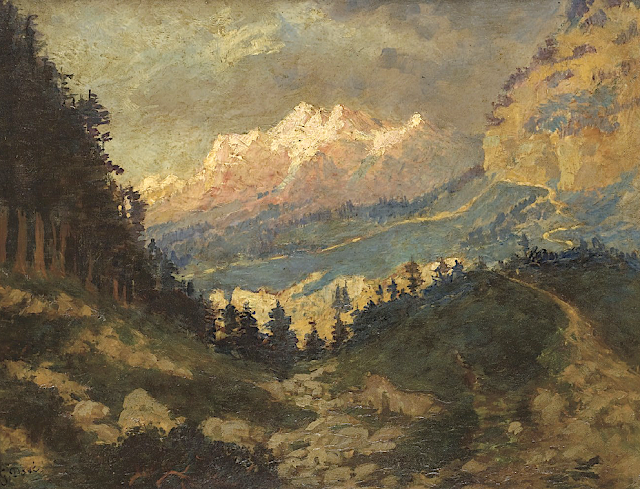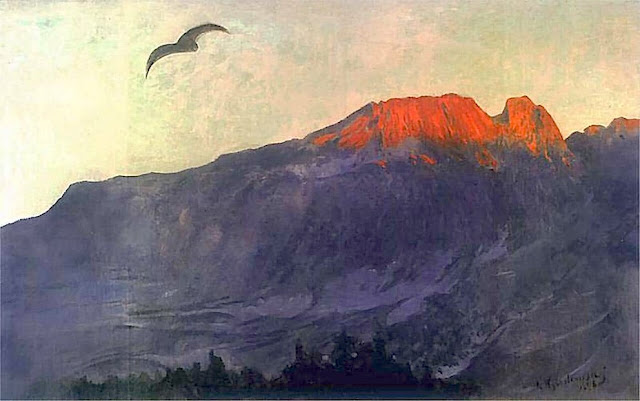Le Grand Combin (4,314 m- 14, 154ft)
Switzerland
In Le Grand Combin, Suisse romande, Oil on panel, 26 x 35 cm. Private collection (Christies)
The mountain
The Grand Combin is a mountain massif in the western Pennine Alps in Switzerland. With its 4,314 metres (14,154 ft) highest summit, the Combin de Grafeneire, it is one of the highest peaks in the Alps and the second most prominent of its range. The Grand Combin is also a large glaciated massif consisting of several summits, among which three are above 4000 metres:
- Combin de Grafeneire (4,314 m -14,154 ft),
- Combin de Valsorey (4,183 m -13,724 ft),
- Combin de la Tsessette (4,134 m -13,563 ft).
The massif of the Grand Combin lies south of Verbier between the Val d'Entremont (west) and Val de Bagnes (west). The north-western facing side of Grand Combin is entirely covered by eternal snows and glaciers which are prone to serac falls. The southern and eastern walls are more steep and thus exempt of snow.
The topography of the Grand Combin is intricate. Between the Val d'Entremont and the Val de Bagnes are two high ridges, nearly parallel to each other and to those valleys, which both diverge from a short transverse ridge of great height. The southern end of the space enclosed between these three ridges is an elevated plateau of great extent, where the snows accumulate and feed the Corbassière Glacier which descends thence for about ten kilometers to the north. The glacier is surrounded by the peaks of Petit Combin, Combin de Corbassière and Combin de Boveire on the west, Grand Tavé and Tournelon Blanc on the east. Smaller glaciers lie on the external flanks such as Boveire and Mont Durand Glacier.
The Grand Combin, which yields in height to only a few European mountains, was long one of the least known of Alpine summits. The first to commence the exploration of the great massif which separates the Val de Bagnes from the Val d'Entremont was Gottlieb Samuel Studer, of Berne, who on August 14, 1851 reached for the first time the summit of the Combin de Corbassière with the guide Joseph-Benjamin Fellay, and has published an account of that and a subsequent excursion in Bergund Gletscher-Fahrten. He was followed in that ascent five years later by W. and C. E. Mathews, and in 1857, William Mathews anticipated Studer in the ascent of the second peak of the Grand Combin.
The first four expeditions on Grand Combin reached only the minor summit east of Grand Combin (Aiguille du Croissant). The first one was made by mountain guides from the valley (Maurice Fellay and Jouvence Bruchez) on July 20, 1857. The first complete ascent of Grand Combin was finally made on July 30, 1859 by Charles Sainte-Claire Deville with Daniel, Emmanuel and Gaspard Balleys, and Basile Dorsaz.
The Grand Combin de Valsorey on the west was reached for the first time on 16 September 1872 by J. H. Isler and J. Gillioz. They climbed the south south face above the Plateau du Couloir. The itinerary on the south-east ridge was opened on 10 September 1891 by O. Glynne Jones, A.Bovier and P. Gaspoz.
The "Penitents", those reliefs of ice that one see rising on the surface of the glacier of the Grand Combin, in this 1787 painting, have all disappeared at the beginning of 21th century, because of global warming...
The painter
Paul-Gustave-Louis-Christophe Doré said Gustave Doré, born January 6, 1832 in Strasbourg and died January 23, 1883 in Paris in his house in the rue Saint-Dominique, is an illustrator, writer, cartoonist, painter and French sculptor. It has been internationally recognized in his lifetime.
In 1851, two albums Three artists misunderstood and unhappy and Des-approval for a pleasure trip are published at Aubert. Freed from the inspiration of Rudolf Töppfer and compliance executives, Gustave Doré performs freely arranged vignettes with several dimensions. The plurality of page composition, its innovations and graphic variants are deployed mainly in Des-approval for a pleasure trip. His technique uses the lithographic pencil, drawing directly on the stone.
Paul Lafon, writer and editor, he had met with Philipon, agreed to his request to illustrate the works of Rabelais. In 1854, the book is published by Bry with 99 vignettes and 14 inset plates engraved on wood. This affordable edition with low printing quality and modest size (large octavo) is not up to the high ambitions of Gustave Doré. In 1854 and 1873 shows two versions of "Rabelais Works" and in 1855: The Hundred Tales of comical by Honoré de Balzac.
In 1856 he illustrates with a painter's hand, The Wandering Jew, a poem set to music by Pierre Dupont, a work break in his artistic career and in the history of the woodcut. Abandoning copper engraving usually privileged, Gustave Doré chooses the color of wood technical (interpretation etching). Doré formed its own school burners. Each plank of the work, with a short caption end of the poem is a work of painting. The large format of the book allows the transition to movies folio. The image is independent of the text. This work is having great success with the public.
Gustave Doré wants to deploy his talent in illustration of the great works of literature, with contempt observed towards caricature and drawing current. It will list the thirty masterpieces in the epic, comic or tragic his ideal library wishing illustrate them in the same format as the Wandering Jew, Dante's Inferno, the Tales by Perrault, Don Quixote, Homer, Virgil, Aristotle, Milton (The lost paradise) or Shakespeare ... The publishers refuse to perform these luxury publications of too much cost. Gustave Doré should self-publish the works of Dante in 1861. The critical and popular success hails striking prints on the text. A critic will assert that: "The author is crushed by the designer. More than Dante illustrated by Doré, Doré is illustrated by Dante. "
In the 1860s, he illustrated the Bible.
He attended high society and expands his pictorial activities it consists of large paintings like Dante and Virgil in the ninth circle of Hell (1861 - 311 × 428 cm - Musée de Brou), The Enigma (Musée d'Orsay ) or the Christ leaving court (1867-1872 - 600 × 900 cm² Museum of modern and Contemporary Art of Strasbourg).
According to Ray Harryhausen, famous designer of special effects, multiplying together drawings and illustrations of all kinds (fantastic, portraits-loads), its reputation extends to Europe, he met a huge success in England with the Doré Gallery that opened in London in 1869. In 1875, the figure of Samuel Coleridge's poem The Rime of the Ancient Mariner (Lament of the Ancient Mariner) published in London by Golden Gallery is one of his greatest masterpieces.
His art of composition culminated in London, a Pilgrimage by Blanchard Jerrold, true story about the London of the late nineteenth century when all classes are present, inspiration is particularly striking in the description of the London slums.
He died of a heart attack at age 51 on January 23, 1883, leaving an impressive work of more than ten thousand pieces, which will have later a strong influence on many illustrators. His friend Ferdinand Foch organizes the funeral at St. Clotilde, burial at Père Lachaise and a farewell meal at 73 rue Saint-Dominique
2022 - Wandering Vertexes...
by Francis Rousseau

















